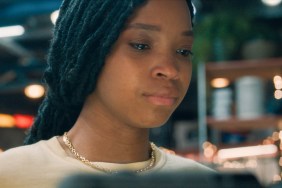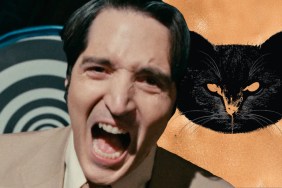The Straight Story: David Lynch’s sweetest movie is also one of his most challenging
David Lynch‘s The Straight Story opens with a view of a starry night sky. As we gaze at (into? through? beyond?) these stars we become aware of quiet, ethereal music, floating in our subconscious like something recalled rather than heard. There’s a faint echo of Laura Palmer‘s theme. Of course there is. Laura’s out there somewhere, a little light from a distant dimension burning in our present. She belongs in this particular patch of sky, shining over Laurens, Iowa, a small town not unlike Twin Peaks, with a similar community of faintly absurd, lost souls… and its fair share of ghosts. We’ll see all that clearly soon enough, but for now we’re looking at stars, reflecting on the fact that we’re looking at the past, that each star is a pinprick of bright, dead light, haunting the darkness of our present.
RELATED: Is The Elephant Man David Lynch’s best film?
Suddenly we are hovering over a front lawn in hot afternoon light. The grass is almost oppressively bright. An obese woman fries herself on a recliner under the glare of the sun. Nothing about this scene is comfortable. Colors are shouting at us, but it’s oh so quiet. So quiet. We begin to descend, at a slow, slow, creeping pace, very gradually advancing over the lawn and up to a darkened side window. Whose eyes are we looking through? Some sort of spirit? Death? That’s the natural assumption. We’re re-visiting the opening of Blue Velvet, surely, this time with a dash of Halloween. This stealthy creep around the outside of the house almost exactly retraces the steps of the young Michael Myers as he spies on his sister…his prey. Are we here to spy on prey? Are we here to kill? Just as we ask ourselves this question we find ourselves staring intently at the deep shadows behind the kitchen window. We hear something drop to the floor, followed by a heavy thud. Someone has fallen. Our presence has been felt.
We expect to be disorientated this early in a David Lynch film but we don’t necessarily expect to feel this strong sense of intimately inhabiting the insidious spirit of mortality. We soon realize that in doing this we are in fact inhabiting the spirit of the protagonist.
When we finally see Alvin Straight lying on his floor, resisting the help of neighbors, we are struck by the mix of self-awareness and defiance in his face. He knows exactly what is wrong with his ailing body – he can sense it. But he does not want anyone else to make a fuss about it. He feels that as long as he can maintain it as his own silent certainty he can control it. The moment he accepts help, practical, medical or otherwise, it will become something bigger than him. His world needs to remain small, secretive. We will see several heartbreaking glimpses of this secret world as we get closer to him.
When Alvin’s daughter, Rose, returns home to find him still lying on the floor, with two neighbors looking increasingly pathetic and defeated, she naturally panics. Now, this is Sissy Spacek playing a woman who has remained essentially child-like. Her look of confusion and raw desperation as she brings her hands to her face belong to the world of horror, the world of Carrie. Thus a moment of great truth also becomes a moment of modern Gothic.

This scene epitomizes the way in which The Straight Story works. The story itself is remarkably true and the characters wonderfully real and while reflecting all this truth the film manages also to appear full of illusion and allusion. We see this at the key moment in which the plot, such as it is, is kicked into action. Alvin and Rose are sitting together in their front room as a dramatic storm flashes outside. In the expert hands of cinematographer Freddie Francis this is a Hammer movie storm, melodramatically enhancing an atmosphere of dread and assaulting the unquiet soul of this little house with restless spirits. The phone rings. We sense it is something ominous. So does Alvin. As Rose takes the call we watch Alvin’s intense features, a granite mask of certainty. He knows it is worrying news. He knows it concerns his brother. He knows this even though there has been no communication between them for the past ten years. He knows this because he is the insidious spirit of mortality. The spirit whose eyes we were looking through in the garden as he crept stealthily up on himself. The spirit who understands the precise nature of the relationship all those in his consciousness have with death and loss. Thus when Rose tells him his brother Lyle has had a stroke there is no flicker of surprise. Instead there is the vivid lightning flash of certainty and resolution (is this storm really taking place or is it a Lynchian illusion, an apt expressionistic psychological projection?). He knows simply that he and his brother must be reunited. The time has come to make a journey.
Now anyone who knows anything about this film knows that this journey is the stuff of legend. The real Alvin Straight traveled hundreds of miles from Iowa to Wisconsin on a tractor lawn mower. In Lynch’s symbolic hands this becomes a mythical odyssey through a haunted autumnal world. The vehicle in the film is a 1966 John Deere model. It has history. It has aches and pains. It is a shadow of its former self. It literally has great hills to climb. Man and machine are one. The insidious spirit of mortality will creep along The Great Open Road and everyone who encounters it will feel both a tug of compassion and a chill of recognition. Isn’t that just like life? This is the wonderful metaphor Lynch offers us. Riding his mechanical steed of gritty determination and gradual triumph, Alvin is both a questing medieval knight and a manifestation of the Reaper. It is no accident that his journey is punctuated by images of harvest. He gathers the souls of everyone he meets, not to claim them but to consider them for a while with the penetrating eye of his spirit, to draw from them their darkest truths. He leaves them slightly shaken but also emboldened, their sense of life and purpose re-affirmed.
You really need to watch or re-watch these encounters for yourself to get their full emotional weight. I want to focus just on one moment of Alvin’s journey to highlight the lightness of Lynch’s quintessential touch in this film. This is the moment when Alvin begins to notice cyclists flitting past him. At first it is the odd little streak of movement. Then Alvin gets off his mower, turns to get a full view of the long road and watches as a great stream of them rushes past him, each one with the almost intangible appearance of a wisp. They seem to have organically materialized out of the landscape, carried on the wind. There is a suggestion of the miraculous about them. There is certainly a sense of life, of energy, of youth. Alvin regards them with a wistful mix of admiration and yearning. He watches them all go by. And then he climbs back on his steed and sets about slowly catching up with them. Much later in the day, as he pulls in to the field where they are setting up camp, we see them gathering round him, applauding. Now it is their turn to be full of admiration. But, we reflect, is there not also perhaps a slight sense of fear? Here, after all, is the steel-willed spirit of time and age, triumphantly trumpeting the inevitability that he will catch up with all of us in due course.

That is, of course, the point. But it is also the point that this moment is seen as a celebration. Ultimately it is the life that remains in Alvin that matters. It is that life that is being recognized, however compromised, however frail, however wrapped in darkness. The fire in Alvin’s soul blazes out of his beautiful eyes and lights everything around him. What still remains of the life in the leaves on the autumn trees burns with a rich, deep, strong flame. This is a film that slows us down until it aches to move. It forces us to be still while we think thoughts we don’t want to think, about grief, about time, about age, about weakness, about death. It forces us to creep up to our own side window and stare into the darkness at ourselves. But then as we look it assaults our eyes with simple, elemental images of such beauty that we feel our appreciation of life being refreshed, enriched by our brush with the spirit of mortality. This is a parable about the harvest which teaches us that walking in step with the reaper is the way to move through life. In short Lynch achieves the kind of spiritual transcendence in this film that Terrence Malick was reaching and straining to achieve with The Tree of Life.
Nowhere is that sense of transcendence more powerful than in the overwhelming final scene. If you have not seen the film I will not ruin it by giving anything away. What I must say is that in an ideal world people would watch The Straight Story as the second part of a double bill with my favorite film of all time, Wim Wenders’ Paris, Texas. The connections would unfold slowly, beautifully, at a rich and very gradual pace, until finally this last scene would hit us as the near miraculous, revelatory epiphany at the end of a remarkable journey.
One could write separate essays on Richard Farnsworth’s extraordinary performance and Angelo Badalamenti‘s vital score, which, perhaps more than with any of the composer’s other organic collaborations with Lynch, is the heart and soul of the film. Let that provoke discussion! For now I have said enough. If you have not already experienced this film then rest assured it will catch up with you. That time will come. And you will feel your heart lifted when it does. Lifted by what is probably the most gentle, beautiful, truthful, compassionate horror film in history.









